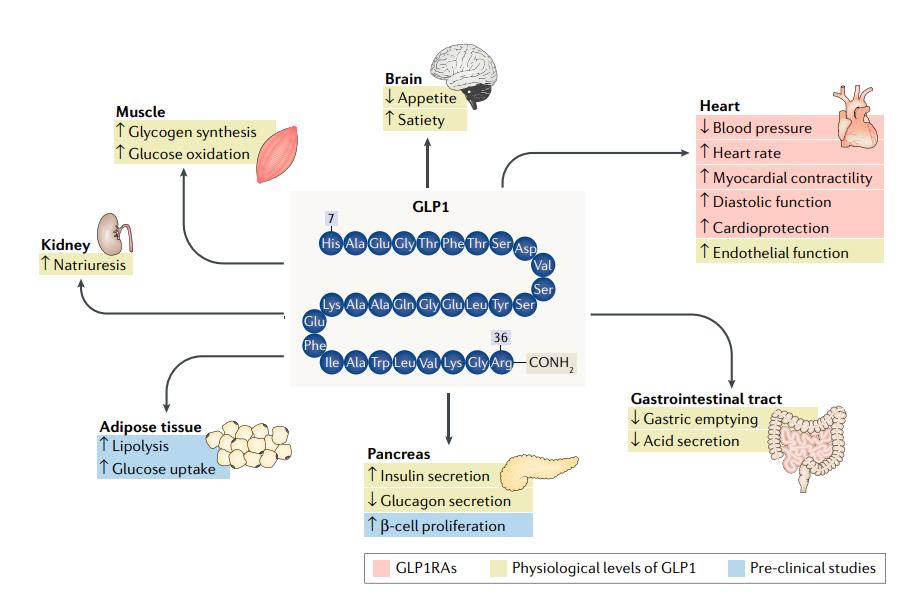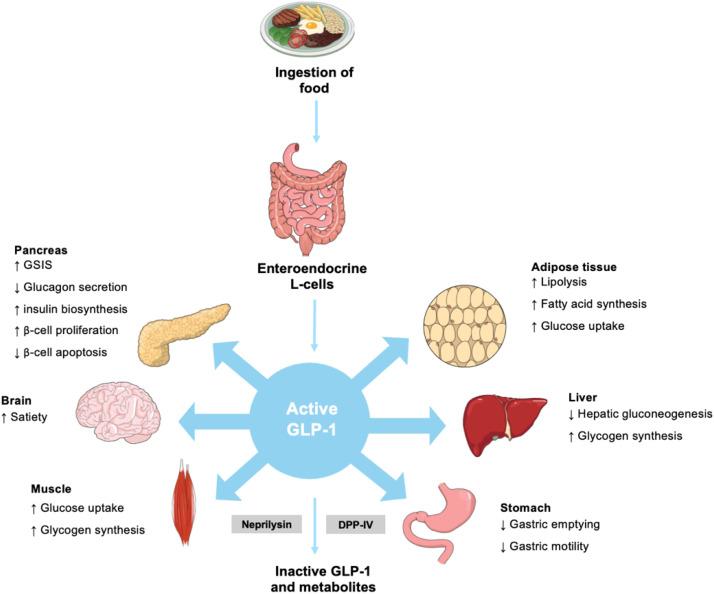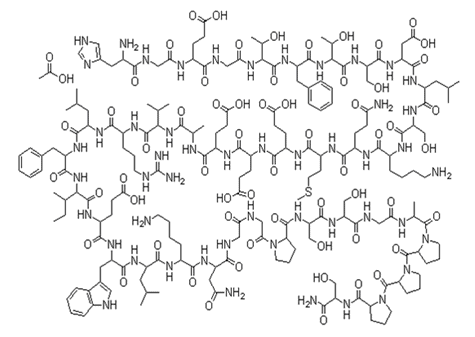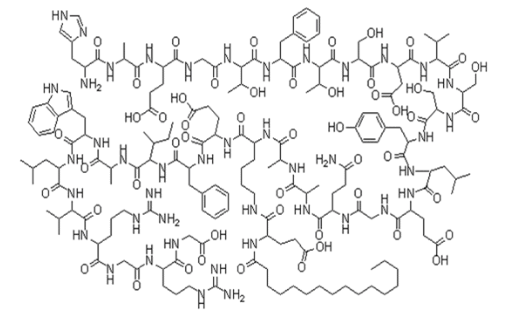2018-08-29
The history of the discovery and research of GLP-1 (Glucagon like peptide-1) can be traced back to the late 60s to early 70s of the 20th century. Initially, scientists discovered the hormone while studying the effects of incretin. In 1964, researchers found that oral glucose promoted insulin secretion significantly more strongly than insulin secretion induced by intravenous glucose, and this effect was defined as the "incretin effect". In 1983, Creutzfeldt's team showed the presence of a second incretin hormone, GLP-1. In 1987, GLP-1 was further recognized as a physiologic incretin.
GLP-1 is a 30 amino acid peptide (molecular weight of 3297.5) secreted by intestinal L-cells in response to meal ingestion with lipids and carbohydrates. GLP-1 exerts its effect by acting on G-protein-coupled receptors located on the pancreatic P-cells. GLP-1 is strongly insulinotropic in humans, and administration of an antagonist to the GLP-1 receptor, exendin 9-39, in healthy subjects suggests that GLP-1 is essential for normal glucose tolerance in humans. There is a decreased plasma concentration of GLP-1 in T2DM, probably due to an impaired secretion of this incretin hormone. In addition, GLP-1 lowers the gastric emptying, which is often accelerated in patients with T2DM. Furthermore, GLP-1 also exerts its action on pancreatic beta cell by promoting its proliferation and neogenesis. GLP-1 also induces the transformation of non-insulin producing cells into insulin synthesizing cells.
 Fig.1 Effects of GLP-1 on various tissues. (Andersen, Andreas, et al., 2018)
Fig.1 Effects of GLP-1 on various tissues. (Andersen, Andreas, et al., 2018)
Table.1 Glucagon like peptide-1 (GLP-1) at Creative Peptides.
GLP-1 works by binding to its specific receptor, GLP-1R. GLP-1R belongs to the G protein-coupled receptor family, which is widely expressed in pancreatic β cells, pancreatic ducts, lung epithelial cells, cardiac atrioventricular cells, vagus nerve afferent neurons, and neurons in multiple regions of the brain. When GLP-1 binds to GLP-1R, it activates G proteins (mainly G proteins), leading to the activation of adenosine cyclase (AC), which increases intracellular cAMP levels and further activates protein kinase A (PKA). This signaling pathway enhances the sensitivity of islet β cells to glucose and promotes the synthesis and release of insulin. In addition, GLP-1 also lowers glucose production in the liver by inhibiting the secretion of glucagon by pancreatic islet α cells, thereby lowering blood glucose levels. At the same time, GLP-1 can delay the rate of gastric emptying and reduce the rapid flow of food into the small intestine, which helps control postprandial blood sugar fluctuations. In the central nervous system, GLP-1 suppresses appetite and increases satiety by acting on specific areas of the hypothalamus, such as the arc region (ARC) and the preoptic region (PVN). This mechanism of action not only helps with weight management, but also lowers blood sugar levels by reducing food intake.
 Fig.2 The regulation of glucose homeostasis by GLP-1. (Mahtani, Karishma, et al., 2022)
Fig.2 The regulation of glucose homeostasis by GLP-1. (Mahtani, Karishma, et al., 2022)
In addition to the above effects, GLP-1 also has anti-inflammatory and cardioprotective effects. For example, GLP-1 exerts a vasodilatory effect by activating endothelial nitric oxide synthase (eNOS), which increases nitric oxide (NO) production. In addition, GLP-1 protects the heart from ischemia-reperfusion injury by reducing the endoplasmic reticulum stress response.
In conclusion, GLP-1 regulates blood glucose levels through a variety of mechanisms, including promoting insulin secretion, inhibiting glucagon secretion, delaying gastric emptying, suppressing appetite, and protecting the cardiovascular and nervous systems. These effects make GLP-1 and its receptor agonists important drug targets for the treatment of type 2 diabetes and obesity.
GLP-1 has shown significant potential in the treatment of obesity in recent years. GLP-1 can suppress appetite, delay gastric emptying, and promote insulin secretion by activating GLP-1 receptors, thereby achieving weight loss. Several studies have shown that GLP-1 analogues have shown significant weight loss effects in clinical trials. For example, semaglutide reduced the average body weight of patients by 13.3% in the study one year later, compared to only 2.6% in the placebo group. In addition, after 72 weeks of treatment, tirzepatide achieved a weight loss of 15.7%. These data suggest that GLP-1 drugs have a significant effect on long-term weight management.
Recent studies have demonstrated that the GLP-1 can be beneficial in patients with type-1 diabetes mellitus. It has been demonstrated that the GLP-1 administration by subcutaneous injection before meals improves glucose control in type 1 diabetes. These effects have been attributed to the deceleration of gastric emptying in response to GLP-1. In addition, GLP-1 can enhance the differentiation, growth and regeneration of pancreatic P-cells in newly diagnosed type 1 diabetes patients.
GLP-1 exerts many biological effects. GLP-1 is responsible for a significant part of the insulin response to oral glucose, and both animal and human studies with GLP-1 receptor antagonists suggest that GLP-1 may be essential for normal glucose tolerance. GLP-1 not only enhances insulin secretion but also suppresses the secretion of glucagon in a glucose-dependent fashion. In other words, the suppression of glucagon by GLP-1 does not occur at hypoglycemic plasma glucose concentrations but requires the presence of euglycemia or hyperglycemia.
Glucagon has a major role in maintaining normal concentrations of glucose in blood, and is often described as having the opposite effect of insulin. GLP-1 has been shown to inhibit glucagon secretion in vivo and in vitro. In patients with T2DM, GLP-1 has been proven to reduce glucagon secretion at hyperglycemic condition. Similar to the GLP-1 effects on insulin secretion, GLP-1 has also been shown to affect glucagon secretion only in the presence of high glucose concentration. The exact mechanism of glucagon inhibition is not yet clear. However, it is hypothesized that inhibition of glucagon secretion can be due to direct effect of GLP-1 receptors on islet a-cells or indirect via stimulation of insulin and somatostatin secretion.
GLP-1 is a product of the proglucagon gene. In the human genome, the proglucagon gene is located on chromosome 17 and spans approximately 10kb. GLP-1, 30 amino acids endogenous proglucagon derived peptide hormone discovered in 1984, is secreted from the intestinal L cells in response to the nutrient ingestion. It has been shown that the posttranslational processing of proglucagon differs in a tissue specific manner. Proprotein convertases (PCs), which are Ca2+ dependent serine proteases, have been shown to cleave proprotein and propeptide to generate biologically active peptides in a tissue specific manner. Seven members of the PC family have been identified which includes furin, PC1/3, PC2, PC4, PACE4, PC5/6 and PC7. PC1/3 in the L-cells of gastrointestinal tract has been shown to be responsible for the production of GLP-1 in the intestine. In the alpha cells the proglucagon is processed by PC2 and releases glicentin related polypeptide, glucagon, and some minor and major proglucagon fragment.
GLP-1 mimetics is a class of synthetic drugs used to treat type 2 diabetes and obesity. These drugs mimic the effects of endogenous GLP-1 by activating GLP-1 receptors to increase insulin secretion, inhibit glucagon secretion, slow gastric emptying, and create feelings of fullness, thereby lowering blood sugar levels.

| CAT# | 10-101-16 |
| Product Name | Exenatide |
| CAS No. | 141732-76-5 |
| Sequence | His-Gly-Glu-Gly-Thr-Phe-Thr-Ser-Asp-Leu-Ser-Lys-Gln-Met-Glu-Glu-Glu-Ala-Val-Arg-Leu-Phe-Ile-Glu-Trp-Leu-Lys-Asn-Gly-Gly-Pro-Ser-Ser-Gly-Ala-Pro-Pro-Pro-Ser-NH2 |
| M.W/Mr. | 4186.6 |
| Molecular Formula | C186H284N50O62S |
A synthetic GLP-1 analogue, Exenatide, is a naturally occurring peptide isolated from the saliva of Gila Lizard (Heloderma Suspectum). It shows better stability in plasma (26 min after intravenous delivery) and has the same effects as GLP-1. Protease stability of the peptide is due to an Ala→Gly mutation on the penultimate N-terminal amino acid. Exenatide is the first FDA approved peptide drug for treatment of Type II diabetes, and is available since 2005 under the commercial name Byetta. It is administered by two subcutaneous (S.C.) injections per day in 5 to 10µg quantities per injection.

| CAT# | 10-101-59 |
| Product Name | Liraglutide |
| CAS No. | 204656-20-2 |
| Sequence | HAEGTFTSDVSSYLEGQAAK [N-(1-oxohexadecyl)-L-γ-glutamyl] EFI AWLVRGRG |
| M.W/Mr. | 3751.2 |
| Molecular Formula | C172H265N43O51 |
Liraglutide is a lipidated analogue of GLP-1 with a further extended half-life: 12 hours after I.V. injection. Owing to a lipid tail on Lys24, liraglutide can bind to albumin in plasma and remain in the blood stream in its active form for longer periods of time without proteolysis and clearance, retaining an effect similar to continuous GLP-1 infusion to the plasma. Liraglutide is dosed once daily, S.C., and has been approved by the FDA for treatment of Type II diabetes.
| CAT# | 10-101-158 |
| Product Name | Albiglutide |
| CAS No. | 782500-75-8 |
| M.W/Mr. | 72970.40 |
| Molecular Formula | C3232H5032N864O979S41 |
A longer-lasting analogue, Albiglutide, has been developed as a once weekly treatment. Considering the advantages of albumin binding for liraglutide, this construct was designed to covalently link albumin to two protease resistant GLP-1 peptides.
Exendin 9-39 and exendin-4 are the most widely used GLP-1 receptor antagonist and agonist, respectively. Since many studies investigating GLP-1 actions use one or both of these peptides, their structure and actions is best described in relation to GLP-1.
Exendin-4 is a 39-aminoacid peptide isolated from the venom of the Gila monster, a poisonous lizard predominantly found in Arizona and New Mexico. Exendin-4 acts as an agonist of the GLP-1 receptor, owing to a 53% sequence homology with GLP-1. Due to the presence of a glycine in position 2 instead of GLP-1's alanine, exendin-4 is resistant to degradation by DPP IV, and therefore has a longer half-life than GLP-1, making it a good candidate for diabetes therapy.
A fragment of exendin-4, exendin 9-39, has been shown to be a pancreatic GLP-1 receptor antagonist in rats and mice, baboons and humans. The presence of a Trp cage at the C-terminal allows binding to the receptor, but the absence of the N-terminal amino acids prevents activation of the receptor.
| CAT# | 10-101-325 |
| Product Name | Semaglutide |
| CAS No. | 910463-68-2 |
| M.W/Mr. | 4113.57 |
| Molecular Formula | C187H291N45O59 |
Semaglutide is a GLP-1 receptor agonist mainly used for the treatment of type 2 diabetes and obesity. It reduces blood glucose levels by mimicking the action of endogenous GLP-1, stimulates insulin secretion and inhibits glucagon secretion, and has a weight-loss effect.
Semaglutide has shown significant efficacy in the treatment of type 2 diabetes. Semaglutide has been shown in several clinical trials to effectively control blood glucose levels, reduce glycosylated hemoglobin (HbA1c) levels, and reduce the risk of cardiovascular events. In addition, semaglutide has also been shown to improve blood lipid metabolism, delay gastric emptying, and reduce the risk of retinopathy.
Semaglutide has also shown good results in the treatment of obesity. Studies have shown that semaglutide significantly reduces body weight and BMI, reduces fat accumulation, and improves metabolic health. The weight loss effect of semaglutide is closely related to its appetite suppressant effect, which reduces food intake by delaying gastric emptying and increasing satiety.
References